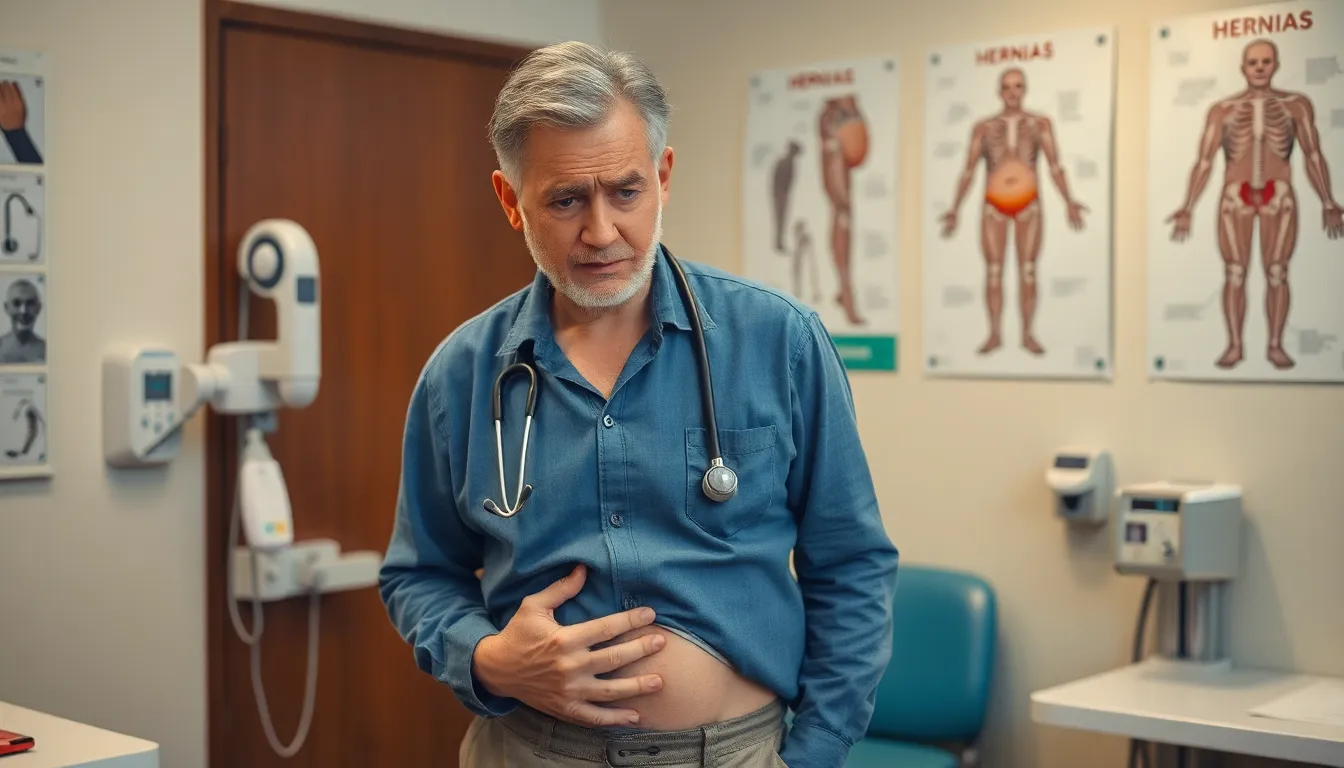Hernias might sound like a punchline from a bad joke, but they’re no laughing matter. Picture this: a small bulge in your abdomen, and suddenly you’re questioning your life choices. Can a hernia actually kill you? It’s a question that’s more pressing than your Uncle Joe’s insistence on sharing his “miracle cure” for everything.
Table of Contents
ToggleUnderstanding Hernias
Hernias represent a significant medical issue that demands attention. They occur when an internal organ or tissue bulges through a weak area in the surrounding muscle or connective tissue.
What Is a Hernia?
A hernia manifests as a protrusion of tissue. Often, this occurs in the abdominal wall, causing visible bulges. The development usually follows increased pressure in the abdomen or weaknesses in the muscle. Factors like aging, heavy lifting, or previous surgeries contribute to these weaknesses. Individuals may experience pain, discomfort, or a feeling of heaviness at the site.
Types of Hernias
Several types of hernias exist, each characterized by its location and cause. Inguinal hernias form in the groin, common among men, while femoral hernias appear in the upper thigh area, primarily affecting women. Umbilical hernias occur at the belly button site. Hiatal hernias, found in the diaphragm, allow stomach tissue to push into the chest cavity. Understanding these variations aids in recognizing symptoms and seeking appropriate treatment.
Risks Associated with Hernias

Understanding the risks associated with hernias is crucial for timely medical intervention. Recognizing symptoms and the potential complications leads to better outcomes.
Symptoms to Watch For
Watch for bulging in the abdomen or groin, which often signals a hernia. Sudden pain during physical activity may indicate worsening conditions. Abdominal discomfort that increases with movement or straining should prompt attention. Nausea or vomiting can occur if the hernia causes obstruction. Fever might indicate infection, while changes in bowel habits can suggest complications. Seek help if symptoms worsen or persist to prevent serious consequences.
Complications of Untreated Hernias
Untreated hernias can lead to severe complications. Strangulation occurs when blood supply to the trapped tissue is cut off, leading to tissue death. Individuals may experience extreme pain and require emergency surgery. Bowel obstruction presents another risk, resulting in nausea and vomiting if intestines become trapped. Chronic pain may develop, impacting daily activities and quality of life. Infection remains a concern, particularly where the hernia presents an opening in the skin. Monitoring hernias closely and seeking treatment is vital to avoid these serious complications.
Can a Hernia Kill You?
A hernia can become life-threatening if not addressed promptly. Complications may arise, particularly strangulation or bowel obstruction, leading to severe health issues.
Medical Perspectives
Healthcare professionals emphasize the dangers of untreated hernias. Strangulation occurs when the blood supply to the herniated tissue is cut off. Serious consequences, such as tissue death, can develop if blood flow is not restored quickly. Patients may present with symptoms like sudden severe pain, nausea, or vomiting, indicating an emergency situation. Timely medical evaluation provides an opportunity for surgical intervention, reducing the risk of fatal outcomes.
Case Studies
Several documented cases highlight the life-threatening potential of untreated hernias. One case involved an individual who ignored abdominal pain, leading to a strangulated hernia. Emergency surgery was necessary to remove necrotic tissue and restore function. Another case showed that a patient with a history of hernias faced bowel obstruction, requiring immediate surgical repair. These examples illustrate the critical importance of recognizing symptoms and seeking medical care.
Treatment Options
Hernias require appropriate medical intervention to avoid complications. Both surgical and non-surgical choices exist for effective management.
Surgical Interventions
Surgery provides the most common and definitive treatment for hernias. Surgeons often perform an open or minimally invasive procedure to repair the muscle wall. An open repair uses a larger incision, allowing for direct access to the hernia. Laparoscopic repair employs small incisions and advanced technology for reduced recovery time. Often, surgical mesh supports the repair, helping to prevent recurrence. Healthcare professionals typically recommend surgery when complications arise or if symptoms worsen, ensuring timely relief.
Non-Surgical Remedies
Non-surgical approaches may alleviate mild hernia symptoms. Healthcare providers might suggest lifestyle changes such as weight management, avoiding heavy lifting, and using supportive garments. These methods help minimize discomfort but do not correct the hernia itself. While some individuals might consider medications to manage pain, these options do not address the underlying issue. Close monitoring often becomes essential, as non-surgical methods do not replace the need for further evaluation if symptoms escalate.
Hernias shouldn’t be taken lightly. While they may seem manageable at first glance they can lead to serious health issues if left untreated. The risk of complications like strangulation or bowel obstruction highlights the necessity of prompt medical attention.
Recognizing symptoms early and seeking appropriate treatment can prevent life-threatening situations. It’s essential for individuals to stay informed about their health and act quickly if they notice any concerning signs. By prioritizing medical care, they can safeguard their well-being and reduce the risks associated with hernias.








